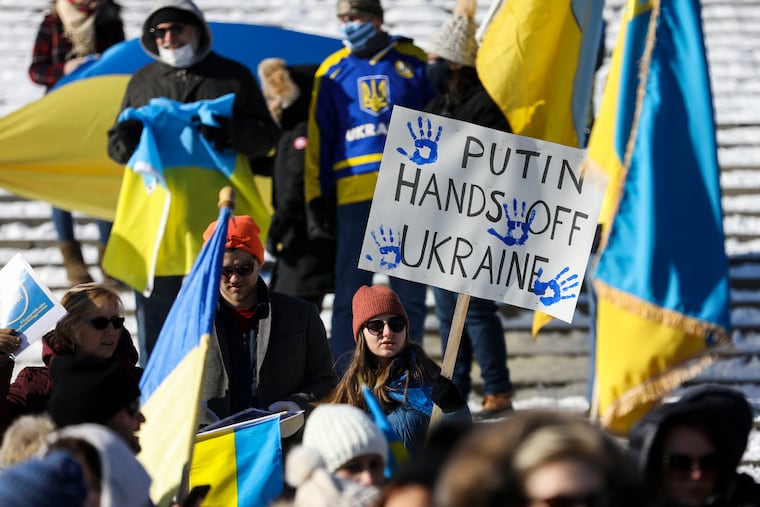Scores rally in Philly to support Ukraine as Russia threatens war
”Ukraine requires direct and immediate support from the United States,” said Eugene Luciw, of the Ukrainian Congress in Philadelphia.

A Ukrainian sea of blue and yellow enveloped the frozen steps of the Philadelphia Museum of Art on Sunday as scores of people rallied to support their embattled ancestral homeland and demand that Russia halt moves toward an invasion.
Local Ukrainians drew backing from others here whose heritage lies in surrounding nations — Poland, Lithuania, Belarus and others. The flags of all those countries snapped in the frigid wind, as speakers offered prayers and poetry.
“I want to hear your voice!” called Iryna Mazur, the honorary consul of Ukraine in Philadelphia, and the crowd responded with a roar.
Horns honked from passing cars. Tourists lined up to take photos by the nearby Rocky statue. From a lone microphone near the base of the famous steps, speaker after speaker denounced Russian President Vladimir Putin and called on the Biden administration to act.
“Ukraine requires direct and immediate support from the United States,” said Eugene Luciw, president of the local chapter of the Ukrainian Congress Committee of America. “You can see by Putin’s demands that he wants to restore the Soviet empire. ... You’re looking at a conflagration on Ukrainian soil that’s going to resemble World War II.”
Ukraine does not belong to NATO, so an attack would not automatically trigger allied intervention.
The “Philadelphia Stands With Ukraine” rally came amid fears of a full-scale Russian invasion, a prospect that has pitted Moscow against Washington and set governments and peoples on edge in countries around the world.
» READ MORE: With Russia threatening war with Ukraine, I'm headed to Kyiv | Trudy Rubin
Russia has moved huge numbers of troops and large amounts of military equipment into the border regions, but could also strike from the air or with artillery. People here fear for the safety of relatives in Ukraine.
On the museum steps, Ann Phillips held up a sign that said, “Not Back in the USSR.” She came from Havertown for the rally, not because of shared heritage, she said, but because she wanted to support a people under terrible threat and duress.
”I don’t think Putin should be able to menace the world,” she said.
Others agreed.
“Nyet, nyet, Putin!” the crowd chanted.
Organizers called on all those present to phone the White House and their congressional representatives, and demand that President Joe Biden institute harsh economic sanctions against Russia — before an invasion occurs.
On Thursday, Biden told his Ukrainian counterpart, Volodymyr Zelensky, that there existed a distinct possibility Russia could invade in February.
That hits hard for people here. About 200 came out in temperatures in the 20s, several in Ukraine hockey jerseys, none letting the weather deter their show of support.
“It’s the least we can do to stand up for democracy,” said Krista Bard, the honorary consul of Lithuania in Pennsylvania. “The word they use over there is ‘solidarity.’”
More than 67,000 Ukrainians live in the Philadelphia region, their heritage reaching to a Black Sea nation of 44 million that’s roughly the size of Texas.
Ukrainian life in this area is rich, vibrant and visible, alive in institutions such as the Ukrainian Educational and Cultural Center in Jenkintown and the Ukrainian Selfreliance Credit Union in Feasterville.
Ukrainians immigrated to the United States in several distinct waves, starting about 1870, when poor farmers, many of them former slaves of the Austro-Hungarian and Russian empires, were drawn here by the promise of paying jobs.
About 240,000 settled in the eastern farmlands of the U.S. or in anthracite coal-mining towns in Pennsylvania and West Virginia. In the early 1900s, as many as 250,000 more Ukrainians arrived, working for big steel, glass, and rail manufacturers in the industrial cities such as Philadelphia, Baltimore, Cleveland, and Detroit.
Ukrainian immigration paused at the start of World War I, and then all but stopped after Congress set limits on immigrants. The Nazis seized virtually all of Ukraine in their 1941 invasion of the Soviet Union.
Initially, the Germans were greeted as liberators, allies for Ukrainian independence. Instead, the Nazis began the mass killing of Ukrainian Jews, at times aided by local auxiliary forces. At war’s end, tens of thousands of displaced Ukrainians came to the U.S., helped by Ukrainian American organizations that the newcomers then revived and expanded.
The Iron Curtain of the Soviet Union cut off new immigration for four decades. It resumed only with the fall of the Berlin Wall in 1989 and official Ukrainian independence in 1991.
Today, about a million Ukrainians live in the U.S. Locally, that includes about 52,000 people of Ukrainian ancestry and an additional 15,000 Ukrainian immigrants who make their homes in the city and the surrounding suburban and South Jersey counties.
At the Art Museum steps, speakers stressed how the effects of a Russian invasion would extend beyond Ukraine’s borders.
“The conflict in Ukraine is not a local conflict — it’s a global conflict,” Mazur said. “We want to reinforce our voices, to stand behind Ukraine.”
Staff writer Ximena Conde contributed to this article.